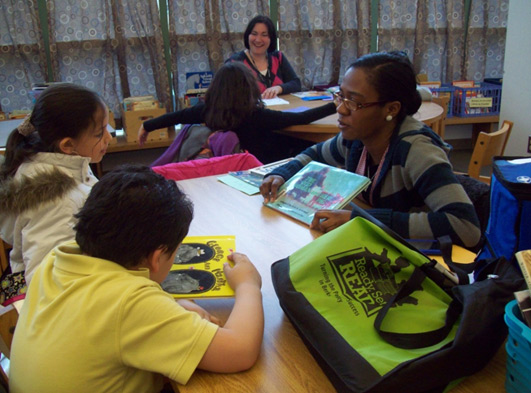IN THIS ISSUE:
Grantee Spotlight: Mercer University Partners to Revitalize Beall’s Hill Neighborhood
University of Massachusetts Creates More than Jobs through the Wellspring Collaborative
Universities Investing in Their Communities: Student- and Administration-Led Approaches
How to Make Place Matter
How to Make Place Matter
On September 12, 2014, Albright College’s new Center for Civic and Global Engagement hosted a conference called “Place Matters: Partnerships between Higher Education and their Local Communities” with the U.S. Department of Housing and Urban Development’s Office of University Partnerships, the Federal Reserve Bank of Philadelphia, and Pennsylvania Campus Compact. Twenty-one speakers highlighted examples of successful anchor institutions throughout Pennsylvania, exploring their ability to improve healthy food access, employment readiness, and educational outcomes of students and community members. In her remarks opening the conference, HUD Region III Administrator Jane Vincent noted that colleges, universities, and other anchor institutions “help sustain the vitality of our nation’s communities.” Anchor institutions, she said, are often ideally situated to create “ladders of opportunity” to help people reach the middle class.

A Ready. Set. Read! volunteer is about to read The Old Woman and Her Pig to two young students.
The resources of anchor institutions can be leveraged for community benefit, explained Steve Dubb, research director at the Democracy Collaborative. These institutions can help staunch the flow of dollars from communities — universities spend $471 billion a year on average and employ 2 percent of the nation’s workforce — by hiring locally, buying locally, and investing in communities. According to Dubb, strategies involving anchor institutions generally work by facilitating local and regional development, providing leadership in a targeted community, and convening coalitions to invest in neighborhoods with challenges. Dubb notes that those developing and implementing an anchor mission must have a process to identify community needs, bring partners to the table, and evaluate the quality and impact of the work.
Community development driven by anchor institutions represents a potentially viable strategy for many Pennsylvania communities that have endured decades of population loss, declines in manufacturing jobs, and high unemployment rates. Keith Wardrip, community development research manager at the Federal Reserve Bank of Philadelphia, cited the example of Reading, Pennsylvania, whose median household income is half that of the national and state median incomes and whose poverty rate is double that of the nation as a whole; in addition, 71 percent of the city’s adult population has no more than a high school education. Despite these challenges, Reading’s population increased by 8 percent between 2000 and 2010, leading Wardrip to ask how the city can best capitalize on its recent population growth.
One possible approach may be promoting access to healthy, nutritious food. The Partnership for a Healthier Berks County, a collaboration spearheaded by Reading Health System, has found that increasing healthy food options stimulates economic activity in addition to supporting better eating habits and decreasing the risk of obesity. One of the partnership’s strategies to expand food options is to focus on small corner stores, which resident surveys indicate are an integral part of the food network in many communities. The partnership is helping corner stores provide a variety of healthy foods and update their in-store displays to encourage healthy food purchases — all part of an effort to use local institutions to promote healthy lifestyles in the community.
Also in Berks County, the United Way’s Ready. Set. READ! initiative is challenging the entire community to become actively involved in every child’s educational success. The stakes for early education are high; children who are not proficient readers by the end of third grade are four times more likely to drop out of high school, and 27 percent of third graders in Berks County are not proficient readers. Ready. Set. READ! is implementing a countywide program to help 90 percent of Berks County’s third graders achieve proficiency by 2023. The program holds classes for parents to help them become their child’s first teacher and uses volunteers who tutor second graders and read to pre-K classes. The United Way serves as the backbone of the initiative, mobilizing the community, collecting data and assessing impacts, and coordinating projects.
At Lafayette University, 50 miles northeast of Reading, fourth-, fifth-, and sixth-grade students participated in STEAM camp, a summer program that incorporates the arts into science, technology, engineering, and mathematics (STEM) activities. Campers participated in multidimensional problem-solving modules run by Lafayette students and faculty that encouraged students to think creatively about how using the five fields together can build a more sustainable world. To demonstrate the lessons they learned from these modules, campers created a sustainable island community in which they had to consider the food, energy, and service needs of potential residents.
For students considering college and careers, Millersville University’s Lancaster Partnership Program is helping students graduate high school, attend college, and find jobs in Lancaster, Pennsylvania. Students at J.P. McCaskey High School meet regularly with program staff to learn the academic and interpersonal skills needed to succeed in higher education, as well as to receive help with the college application process. Students are also eligible for merit-based scholarships to Millersville University, and the program includes a mentoring component that helps students find jobs and internships with corporate sponsors. The program’s participants have a high school graduation rate of 100 percent (compared with 76 percent for the school’s entire senior class), and 73 percent of the program’s participants will pursue post-secondary education, including 27 incoming freshmen who will attend Millersville in fall 2015.
Underscoring many of the conference’s presentations was the need to set measurable benchmarks and collect quality data to assess how anchor institutions can improve the strategies employed. Developing an effective anchor institution strategy can be essential for many communities because, as Vincent notes, “difficult times have made partnerships between anchor institutions and their communities more important than ever.”


